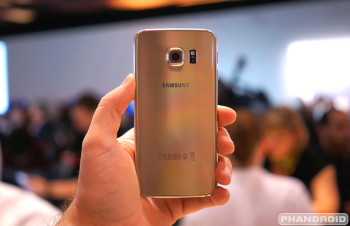
Galaxy S6 vs iPhone 6: camera sample comparison
We’ve already seen how the Samsung Galaxy S6 compares to the iPhone 6 in terms of its physical attributes, but we wanted to get an even better idea of how the two devices stacked up in terms of performance. Using what we had on hand, we put the camera of each phone to the test.
[In all subsequent test images, the Galaxy S6 appears first followed by the iPhone 6. Click to make each larger.]
The immediate takeaway? There is definitely a difference in default white balance for the two. You can decide for yourself, but the iPhone 6 certainly has a more natural-looking color profile. The whites captured by the GS6 take on a off-white, almost yellow hue.
The Galaxy S6 on the whole seems to produce images that are slightly darker than its iPhone counterpart, a quality that is very apparent given the shooting conditions we had (lots of bright lighting, a tony of shiny/reflective white surfaces). The impression is that the iPhone 6 camera is a bit more effortless than the Galaxy S6 when it comes to point-and-shoot photography. For the S6, getting the perfect shot will likely take a bit more fiddling around with settings and scene.
One area where the S6’s camera excels is resolution. The phone’s 16MP shooter provides clarity beyond the iPhone’s sensor at close zoom levels. You can see a comparison in the two images above.
The Galaxy S6 clearly offered the better front facing camera, as seen in the side-by-side photos above. Strangely, the selfie cam didn’t seem as plagued by white balance issues, and it offers photos of superbly higher resolution and clarity than that of the iPhone. Compare to the images of Chris’ mug just prior to the front-facing shots. Captured with the rear camera, they give a good comparison of how the skin tone and other colors look across the two devices and their multiple camera sensors.
Above is the best we could get to replicating lowlight conditions at Samsung’s demo stations (we tucked the above Android pins into a cabinet). As you can see, this was far from the darkest of shooting conditions, but the iPhone 6 (right) was a bit more up to the task than the Galaxy S6.
The final photographic results are important, but there are other things that go into making a smartphone camera unique or useful. As with previous releases, Samsung offer far more robust camera software than Apple, giving users a plethora of options. The scene settings and other tweaks add flexibility to the GS6 that isn’t really present with the iPhone 6 (though Apple has slowly been beefing up the software side of their camera in recent releases). The Galaxy S6 also promises super fast shooting with a camera app that Samsung claims can be launched in 0.7 seconds after double-tapping the phone’s home button.
A camera’s performance often comes down to how you use it, so mileage will always vary. While we think it’s pretty clear that Apple’s phone plays nicer with lighting and gives us photos with truer whites, it can’t match the clarity or versatility of the Galaxy S6. Check out more camera samples below.